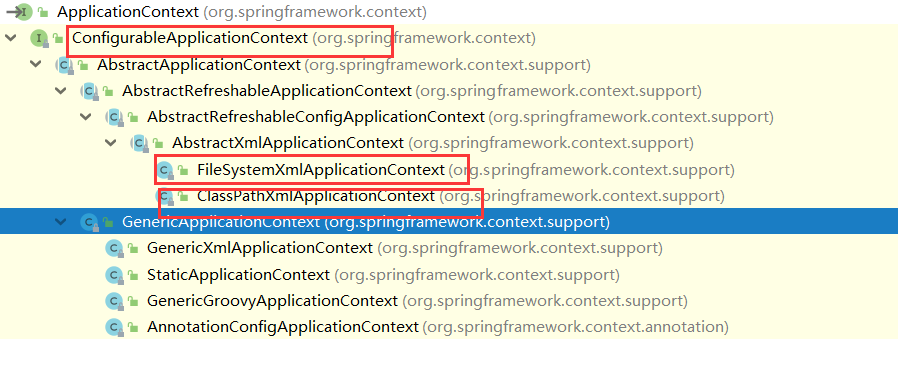IOC和DI
网上概念很多,感兴趣可以去搜一搜,在这里我就给个比喻:
IOC:以前我们买东西都要去商店买,用了IOC之后,我们只要在门口放个箱子, Spring就会给我相应商品,ಠᴗಠ
举个例子
-
class A{}
-
-
class B{
-
private A a;
-
public void setA(A a){
-
this.a=a;
-
}
-
}
在传统的写法中,在创建A B对象,他们之间的关联需要我们手动设置,b.set(a),而在使用Spring之后,这一步就不需要了,由框架为我们设置相关内容
IOC的发展:
- 分离接口与实现
- 工厂设计模式
- 翻转控制
基于XML配置bean
<bean>中的class属性填入bean的全类名,通过反射方式在IOC容器中创建Bean,所以要求Bean中必须有无参的构造函数。
属性id用来表示容器中的id,id唯一
ApplicationContext代表IOC容器,实际这是一个接口。在SpringIOC容器读取Bean配置创建Bean实例之前,必须对它进行实例化,只有在容器实例化后,才可以从IOC容器里获取Bean实例并使用。
Spring为我们提供了两种类型的IOC容器实现:
- BeanFactory:IOC容器的基本实现
- ApplicationContext:提供了更多高级特性,是BeanFactory的子接口
- ClassPathXmlApplicationContext是ApplicationContext的实现类
BeanFactory是Spring的基础设施,面向Spring本身,ApplicationContext面向Spring框架开者,几乎所有应用场合都直接使用ApplicationContext而非底层BeanFactory,当然,无论使用何种方式,配置文件都相同。

ApplicationContext的主要实现类:
ClassPathXmlApplicationContext:从类路径下加载配置文件
FileSystemXmlApplicationContext:从文件系统中加载配置文件

ConfigurableApplicationContext扩展于ApplicationContext,新增两个主要方法:refresh()和close(),让ApplicationContext具有启动/刷新和关闭上下文的功能。
ApplicationContext在初始化上下文时就实例化所有单例的Bean。
WebApplication是专门为WEB应用而准备的,它允许从相对于WEB根目录的路径中完成初始化工作。
接下来说说getBean()这个方法,getBean()这个方法实际是存在在BeanFactory这个接口中,我们看看下面这张截图:

非常多个重载,我们在之前的例子中也可以这么写,利用类型返回IOC容器:
HelloWorld helloWorld = ctx.getBean(HelloWorld.class);
也是没问题的,这样有缺点吗?
加入我在配置文件中创建了两个<bean>并且都是HelloWorld的JavaBean,这样Spring就识别不出是哪一个<bean>了,因此不推荐这么写,推荐通过id名返回IOC容器,创建对象
HelloWorld helloWorld = (HelloWorld) ctx.getBean("helloWorld");
依赖注入
- 属性注入
- 构造器注入
- 工厂方法注入(很少使用,不推荐)
先说说最常用的属性注入,这个属性注入就是我们先前HelloWorld中使用的方法,通过setter方法注入Bean的属性值或依赖的对象,通过<property>标签,使用name指定Bean的属性名称,value属性指定属性值
<property name="name" value="World"></property>
接着说构造方法注入,通过构造方法注入Bean的属性值或依赖对象,它保证了Bean实例在实例化后就可以使用。
构造器注入需要用<constructor-arg>元素里声明属性,注意<constructor-arg>中没有name属性
我们新创建Car类作为测试:
-
public class Car {
-
private String brand;
-
private String corp;
-
private Integer price;
-
private Integer maxSpeed;
-
-
public Car(String brand, String corp, Integer price) {
-
this.brand = brand;
-
this.corp = corp;
-
this.price = price;
-
}
-
-
@Override
-
public String toString() {
-
return "Car{" +
-
"brand='" + brand + ''' +
-
", corp='" + corp + ''' +
-
", price=" + price +
-
", maxSpeed=" + maxSpeed +
-
'}';
-
}
-
}
这里故意在构造器里少放一个字段,来到配置文件
-
<bean id="car" class="com.figsprite.bean.Car">
-
<constructor-arg value="奥迪"></constructor-arg>
-
<constructor-arg value="上海"/>
-
<constructor-arg value="3000000"/>
-
</bean>
在Main中输入测试代码:
-
Car car = (Car)ctx.getBean("car");
-
System.out.println(car.toString());

看结果,很有意思的是我已经将HelloWorld.java相关的代码注释了,可是还是出现了我们上一讲所写的注释,这就应证了之前所说的:
ApplicationContext在初始化上下文时就实例化所有单例的Bean。
接下来再配置一个构造器:
-
public Car(String brand, String corp, int price, int maxSpeed) {
-
this.brand = brand;
-
this.corp = corp;
-
this.price = price;
-
this.maxSpeed = maxSpeed;
-
}
来到配置文件:
-
<bean id="car2" class="com.figsprite.bean.Car">
-
<constructor-arg value="海南马自达"></constructor-arg>
-
<constructor-arg value="上海"/>
-
<constructor-arg value="3000000"/>
-
<constructor-arg value="78"/>
-
</bean>
-
Car car2 = (Car)ctx.getBean("car2");
-
System.out.println(car2.toString());
发现没什么问题,但如果构造器是品牌名、场地、最大速度,Spring能识别出来吗?
先将price改成double,否则不满足重载规则,写上新的配置文件
-
<bean id="car2" class="com.figsprite.bean.Car">
-
<constructor-arg value="海南马自达"></constructor-arg>
-
<constructor-arg value="上海"/>
-
<constructor-arg value="78"/>
-
</bean>
发现并没有得到我们想要的,如何解决这个问题呢?

此时需要用到type属性,
-
<bean id="car" class="com.figsprite.bean.Car">
-
<constructor-arg value="奥迪" type="java.lang.String"></constructor-arg>
-
<constructor-arg value="上海" type="java.lang.String"/>
-
<constructor-arg value="3000000" type="double"/>
-
</bean>
-
-
<bean id="car2" class="com.figsprite.bean.Car">
-
<constructor-arg value="海南马自达" type="java.lang.String"></constructor-arg>
-
<constructor-arg value="上海" type="java.lang.String"/>
-
<constructor-arg value="78" type="int"/>
-
</bean>
嗯,是我们想要的了,使用构造器注入属性值可以指定参数的位置和参数类型,这里还有一个index的属性,用于不按构造器参数顺序写标签时使用。大家可以自行尝试一下
